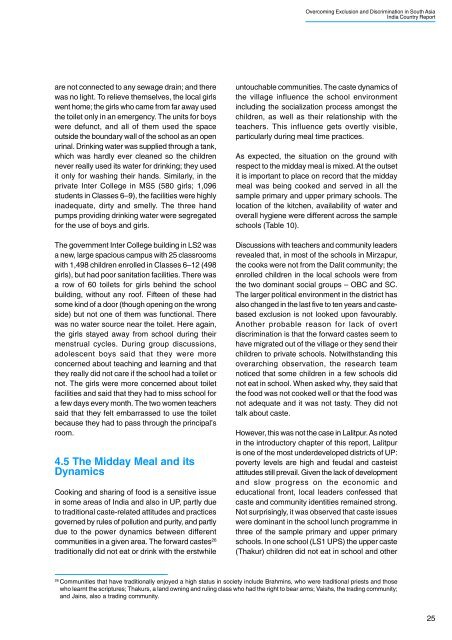Equity in School Water and Sanitation
Equity in School Water and Sanitation
Equity in School Water and Sanitation
You also want an ePaper? Increase the reach of your titles
YUMPU automatically turns print PDFs into web optimized ePapers that Google loves.
Overcom<strong>in</strong>g Exclusion <strong>and</strong> Discrim<strong>in</strong>ation <strong>in</strong> South AsiaIndia Country Reportare not connected to any sewage dra<strong>in</strong>; <strong>and</strong> therewas no light. To relieve themselves, the local girlswent home; the girls who came from far away usedthe toilet only <strong>in</strong> an emergency. The units for boyswere defunct, <strong>and</strong> all of them used the spaceoutside the boundary wall of the school as an openur<strong>in</strong>al. Dr<strong>in</strong>k<strong>in</strong>g water was supplied through a tank,which was hardly ever cleaned so the childrennever really used its water for dr<strong>in</strong>k<strong>in</strong>g; they usedit only for wash<strong>in</strong>g their h<strong>and</strong>s. Similarly, <strong>in</strong> theprivate Inter College <strong>in</strong> MS5 (580 girls; 1,096students <strong>in</strong> Classes 6–9), the facilities were highly<strong>in</strong>adequate, dirty <strong>and</strong> smelly. The three h<strong>and</strong>pumps provid<strong>in</strong>g dr<strong>in</strong>k<strong>in</strong>g water were segregatedfor the use of boys <strong>and</strong> girls.The government Inter College build<strong>in</strong>g <strong>in</strong> LS2 wasa new, large spacious campus with 25 classroomswith 1,498 children enrolled <strong>in</strong> Classes 6–12 (498girls), but had poor sanitation facilities. There wasa row of 60 toilets for girls beh<strong>in</strong>d the schoolbuild<strong>in</strong>g, without any roof. Fifteen of these hadsome k<strong>in</strong>d of a door (though open<strong>in</strong>g on the wrongside) but not one of them was functional. Therewas no water source near the toilet. Here aga<strong>in</strong>,the girls stayed away from school dur<strong>in</strong>g theirmenstrual cycles. Dur<strong>in</strong>g group discussions,adolescent boys said that they were moreconcerned about teach<strong>in</strong>g <strong>and</strong> learn<strong>in</strong>g <strong>and</strong> thatthey really did not care if the school had a toilet ornot. The girls were more concerned about toiletfacilities <strong>and</strong> said that they had to miss school fora few days every month. The two women teacherssaid that they felt embarrassed to use the toiletbecause they had to pass through the pr<strong>in</strong>cipal’sroom.4.5 The Midday Meal <strong>and</strong> itsDynamicsCook<strong>in</strong>g <strong>and</strong> shar<strong>in</strong>g of food is a sensitive issue<strong>in</strong> some areas of India <strong>and</strong> also <strong>in</strong> UP, partly dueto traditional caste-related attitudes <strong>and</strong> practicesgoverned by rules of pollution <strong>and</strong> purity, <strong>and</strong> partlydue to the power dynamics between differentcommunities <strong>in</strong> a given area. The forward castes 26traditionally did not eat or dr<strong>in</strong>k with the erstwhileuntouchable communities. The caste dynamics ofthe village <strong>in</strong>fluence the school environment<strong>in</strong>clud<strong>in</strong>g the socialization process amongst thechildren, as well as their relationship with theteachers. This <strong>in</strong>fluence gets overtly visible,particularly dur<strong>in</strong>g meal time practices.As expected, the situation on the ground withrespect to the midday meal is mixed. At the outsetit is important to place on record that the middaymeal was be<strong>in</strong>g cooked <strong>and</strong> served <strong>in</strong> all thesample primary <strong>and</strong> upper primary schools. Thelocation of the kitchen, availability of water <strong>and</strong>overall hygiene were different across the sampleschools (Table 10).Discussions with teachers <strong>and</strong> community leadersrevealed that, <strong>in</strong> most of the schools <strong>in</strong> Mirzapur,the cooks were not from the Dalit community; theenrolled children <strong>in</strong> the local schools were fromthe two dom<strong>in</strong>ant social groups – OBC <strong>and</strong> SC.The larger political environment <strong>in</strong> the district hasalso changed <strong>in</strong> the last five to ten years <strong>and</strong> castebasedexclusion is not looked upon favourably.Another probable reason for lack of overtdiscrim<strong>in</strong>ation is that the forward castes seem tohave migrated out of the village or they send theirchildren to private schools. Notwithst<strong>and</strong><strong>in</strong>g thisoverarch<strong>in</strong>g observation, the research teamnoticed that some children <strong>in</strong> a few schools didnot eat <strong>in</strong> school. When asked why, they said thatthe food was not cooked well or that the food wasnot adequate <strong>and</strong> it was not tasty. They did nottalk about caste.However, this was not the case <strong>in</strong> Lalitpur. As noted<strong>in</strong> the <strong>in</strong>troductory chapter of this report, Lalitpuris one of the most underdeveloped districts of UP:poverty levels are high <strong>and</strong> feudal <strong>and</strong> casteistattitudes still prevail. Given the lack of development<strong>and</strong> slow progress on the economic <strong>and</strong>educational front, local leaders confessed thatcaste <strong>and</strong> community identities rema<strong>in</strong>ed strong.Not surpris<strong>in</strong>gly, it was observed that caste issueswere dom<strong>in</strong>ant <strong>in</strong> the school lunch programme <strong>in</strong>three of the sample primary <strong>and</strong> upper primaryschools. In one school (LS1 UPS) the upper caste(Thakur) children did not eat <strong>in</strong> school <strong>and</strong> other26Communities that have traditionally enjoyed a high status <strong>in</strong> society <strong>in</strong>clude Brahm<strong>in</strong>s, who were traditional priests <strong>and</strong> thosewho learnt the scriptures; Thakurs, a l<strong>and</strong> own<strong>in</strong>g <strong>and</strong> rul<strong>in</strong>g class who had the right to bear arms; Vaishs, the trad<strong>in</strong>g community;<strong>and</strong> Ja<strong>in</strong>s, also a trad<strong>in</strong>g community.25












